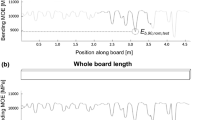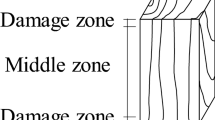Abstract
Tests on glulam were simulated to determine the compressive strength. Based on the values obtained, three strength models were derived. They describe the compressive strength in terms of the density of the sawn timber used, the moisture content of the glulam and, optionally, of the knot area ratio. One of the models, based on density and moisture content, provides satisfying accuracy for engineering applications. Accordingly, glulam with 12 % moisture content has a predicted strength which is 50 % higher compared to glulam with 20 %. If the moisture content amounts to 20 % and the characteristic density of the sawn timber exceeds 350 kg/m3, the predicted strength is lower compared to corresponding nominal values in current product standards. It is suggested to separate the compressive strength for glulam with a maximum moisture content of 12 % which corresponds to service class 1 and of 20 % for service class 2. By this, significantly higher strength values could be used for compression members in service class 1.
Zusammenfassung
Die Druckfestigkeit von Brettschichtholz in Faserrichtung wurde durch Simulationen bestimmt. Aus den so ermittelten Festigkeitswerten wurden drei Festigkeitsmodelle hergeleitet. Diese beschreiben die Druckfestigkeit in Abhängigkeit von der Schnittholz-Rohdichte, der Holzfeuchte des Brettschichtholzes und – wahlweise – von der Ästigkeit. Das einfachste der Modelle, auf Rohdichte und Holzfeuchte beruhend, eignet sich für Ingenieuranwendungen. Demnach besitzt Brettschichtholz bei einer Holzfeuchte von 12 % die 1,5fache Festigkeit im Vergleich zu Brettschichtholz mit einer Holzfeuchte von 20 %. Bei 20 % Holzfeuchte und ab einer charakteristischen Schnittholz-Rohdichte größer 350 kg/m3 liegen die Modellwerte unter den Nennwerten in entsprechenden Produktnormen. Es wird vorgeschlagen, die Druckfestigkeit für eine maximale Holzfeuchte von 12 % (entsprechend Nutzungsklasse 1) beziehungsweise 20 % (Nutzungsklasse 2) getrennt zu definieren. Damit wären für die Bemessung von Druckgliedern in der Nutzungsklasse 1 wesentlich höhere Werte verfügbar.











Similar content being viewed by others
References
Blaß HJ (1987) Tragfähigkeit von Druckstäben aus Brettschichtholz unter Berücksichtigung streuender Einflussgrößen. Universität Karlsruhe (TH), Dissertation
DIN EN 1995-1-1 (2010) Design of timber structures—Part 1-1: General—Common rules and rules for buildings. DIN Deutsches Institut für Normung e.V., Berlin
DIN 4074-1 (2008) Sortierung von Holz nach der Tragfähigkeit—Teil 1: Nadelschnittholz (Strength grading of wood—Part 1: Coniferous sawn timber). DIN Deutsches Institut für Normung e.V., Berlin
Ehlbeck J, Colling F, Görlacher R (1985) Einfluss keilgezinkter Lamellen auf die Biegefestigkeit von Brettschichtholzträgern—Eingangsdaten für das Rechenmodell. Holz Roh Werkst 43:369–373
EN 1194 (1999) Timber structures—Glued laminated timber—Strength classes and determination of characteristic values. European Committee for Standardization, Brussels
EN 408 (2010) Timber structures—Structural timber and glued laminated timber—Determination of some physical and mechanical properties. European Committee for Standardization, Brussels
Frese M, Chen Y, Blaß HJ (2010) Tensile strength of spruce glulam. Eur J Wood Prod 68:257–265
Frese M, Enders-Comberg M, Blaß HJ, Glos P (2011) Strength of spruce glulam subjected to longitudinal compression. Alghero, Italy. (CIB-W18/44-12-2)
Glos P (1978) Zur Bestimmung des Festigkeitsverhaltens von Brettschichtholz bei Druckbeanspruchung aus Werkstoff- und Einwirkungskenngrößen. Berichte zur Zuverlässigkeitstheorie der Bauwerke, Heft 35/78, Laboratorium für den konstruktiven Ingenieurbau, TU München
Glos P, Maier W, Weigle U (1973) Bestimmung des Festigkeitsverhaltens von Fichtenbrettschichtholz als Grundlage für ein probabilistisches Bemessungsverfahren. Teil 1: Versuchseinrichtung für Kurzzeit-Druckversuche. Arbeitsberichte zur Sicherheitstheorie der Bauwerke, Heft 7/73, Laboratorium für den konstruktiven Ingenieurbau, TU München
Kollmann F (1982) Technologie des Holzes und der Holzwerkstoffe. 2. Aufl., Springer-Verlag, Berlin, Göttingen, Heidelberg
prEN 14080 (2011-01) Timber structures—Glued laminated timber and glued solid timber—Requirements. European Committee for Standardization, Brussels
Author information
Authors and Affiliations
Corresponding author
Rights and permissions
About this article
Cite this article
Frese, M., Enders-Comberg, M., Blaß, H.J. et al. Compressive strength of spruce glulam. Eur. J. Wood Prod. 70, 801–809 (2012). https://doi.org/10.1007/s00107-012-0623-x
Received:
Published:
Issue Date:
DOI: https://doi.org/10.1007/s00107-012-0623-x




